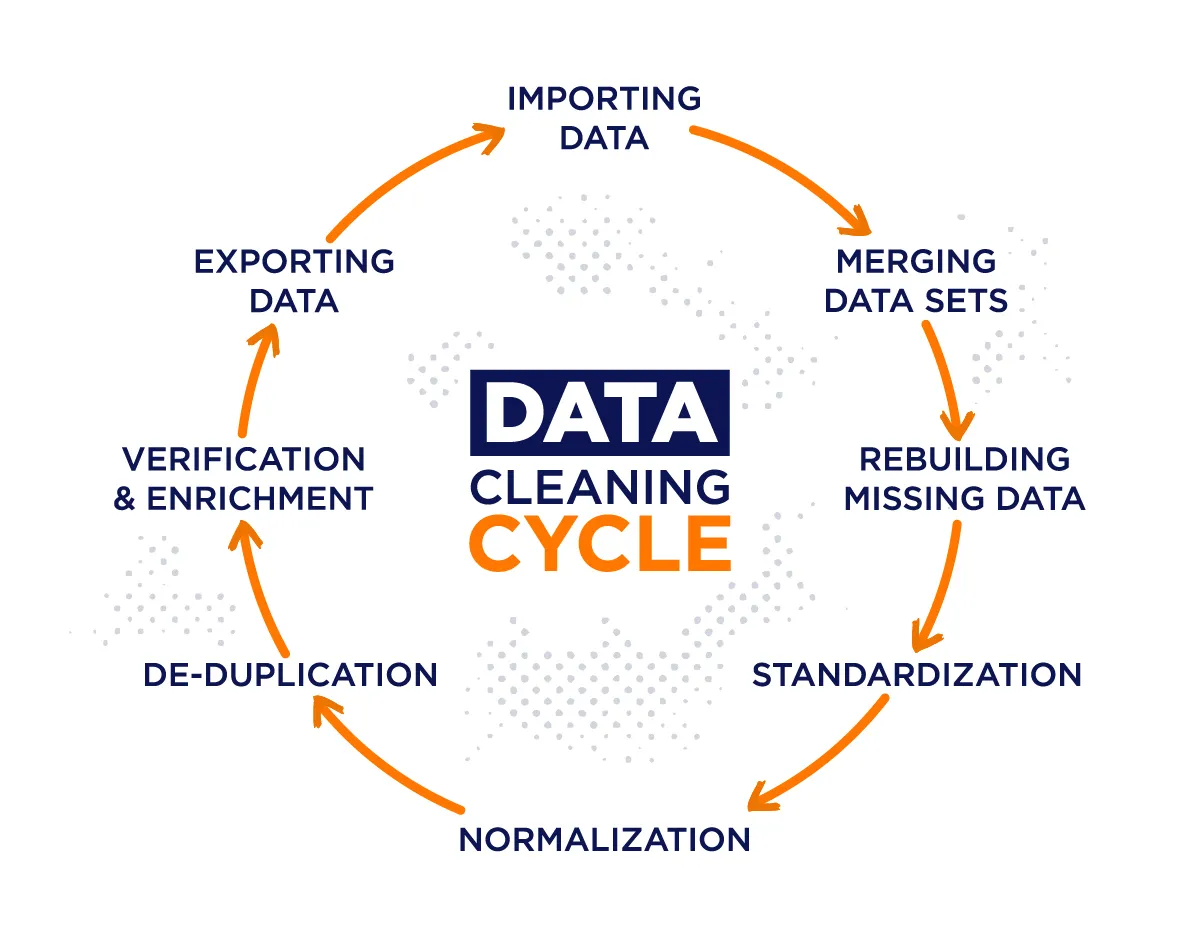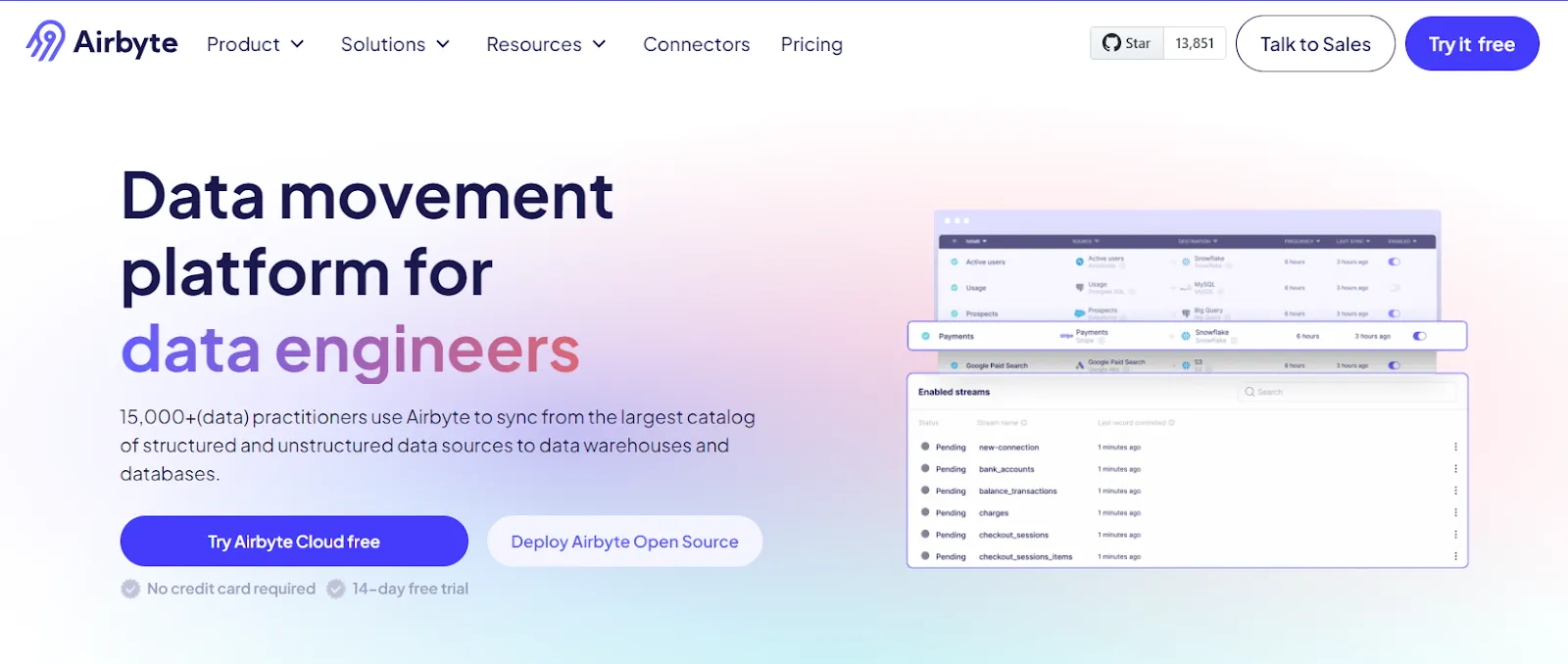Data Cleaning: What It Is, Procedure, Best Practices
Summarize this article with:
✨ AI Generated Summary
Modern data cleansing is essential for transforming raw data into accurate, reliable assets that support AI-driven decision-making and analytics. Key points include:
- Systematic cleansing improves data accuracy, operational efficiency, and reduces costs by removing duplicates, fixing errors, and standardizing formats.
- Embedding cleansing within data governance frameworks ensures alignment with policies, stewardship roles, and continuous quality monitoring.
- AI-powered automation enhances cleansing through pattern recognition, real-time validation, and predictive quality management.
- Platforms like Airbyte facilitate scalable cleansing workflows with schema management, integration with transformation tools (e.g., dbt), and support for diverse data types.
Modern data cleansing represents the foundation of reliable data infrastructure, enabling organizations to transform raw information into trustworthy business assets. By implementing systematic data-cleansing processes, teams can eliminate the quality bottlenecks that constrain analytical capabilities while establishing the data integrity required for AI-driven decision-making.
This article examines the comprehensive data-cleansing process, explores advanced automation techniques, and provides actionable frameworks for maintaining data quality at enterprise scale.
What Is Data Cleansing?

Data cleansing (also called data cleaning or data scrubbing) is the systematic process of correcting inaccurate, missing, duplicate, or otherwise erroneous data in a dataset. This process involves identifying and fixing data mistakes by adding, deleting, or altering records to maintain the reliability and accuracy of data used for analysis or machine-learning algorithms.
Effective data cleansing establishes the foundation for trustworthy analytics by ensuring data accuracy, completeness, consistency, and timeliness. This transformation from raw, inconsistent data to reliable business assets enables organizations to support AI initiatives, regulatory compliance, and strategic decision-making with confidence.
What Are the Benefits of Data Cleaning?
Data cleaning serves as the cornerstone of reliable data operations, delivering measurable improvements across analytical accuracy, operational efficiency, and business outcomes.
Make Data Analytics-Ready
Data cleansing removes duplicates, errors, and irrelevant values while validating data structure and content before transformation or warehousing. Clean data underpins accurate BI dashboards, predictive models, and automated decision-making systems by ensuring analytical inputs reflect true business conditions rather than data artifacts. Organizations with systematic cleansing processes report significant improvements in model accuracy and stakeholder confidence in analytical outputs.
Enhances Operational Efficiency
Accurate, comprehensive customer data enables sales and support teams to communicate effectively, offer tailored services, and address problems quickly—boosting productivity and customer satisfaction. Organizations with clean data report faster decision-making processes, reduced time spent on data verification, and increased focus on strategic analysis rather than data correction activities.
Cost-Effective Solution
Clean data avoids unnecessary expenses by eliminating redundant processing, focusing resources on promising leads, and reducing compliance risks and rework costs. Systematic data cleansing prevents the accumulation of technical debt that requires expensive remediation efforts while ensuring resources are invested in high-value business activities rather than data-quality firefighting.
What Are the Steps Involved in the Data Cleansing Process?
The systematic data-cleansing process follows a structured methodology that ensures comprehensive quality improvement while maintaining data integrity throughout the transformation workflow. This process requires careful planning, execution, and validation to achieve reliable results.
1. Define Data-Cleansing Objectives
- Start by deciding what “clean” means for your business. Review your data to identify common issues such as missing fields, duplicates, or inconsistent formats.
- Once you know what needs fixing, set clear goals and success metrics—for example, ensuring there are no duplicate records or standardizing all dates to a single format like YYYY-MM-DD.
2. Remove Duplicates and Irrelevant Records
- Duplicate and outdated entries can distort your results. Identify and remove repeated or irrelevant data, keeping only the most accurate and up-to-date records.
- Automating this step helps reduce manual work and ensures your reports reflect real, reliable information.
3. Fix Formatting and Structural Errors
- Next, standardize your data so that every field follows a consistent structure.
- This includes fixing capitalization, formatting dates, normalizing country or state names, and aligning field types across systems.
- Consistent formatting ensures that your tools can process and interpret data without errors.
4. Handle Outliers Carefully
- Outliers are data points that differ drastically from the rest. Identify these unusual values and decide whether they are genuine or incorrect.
- For example, an unusually high sales number might be a real transaction or a misplaced decimal.
- Review each case and make corrections where necessary while keeping legitimate data intact.
5. Fill or Address Missing Data
- Missing values can lead to incomplete insights. Find records with gaps and fill them using suitable methods—like taking the average, pulling information from other reliable sources, or predictive estimation.
- If a record lacks too much information, it may be better to remove it entirely to maintain quality.
6. Validate and Review the Cleaned Data
- After cleaning, validate your data to make sure it meets your business rules and formatting standards.
- Cross-check information with source systems, test relationships between data points (like customer and order IDs), and confirm that everything is complete and accurate.
- This final review ensures your data is trustworthy and ready to use for analysis or decision-making.
How Do You Integrate Data Cleansing Within Data Governance Frameworks?
Data cleansing operates most effectively when embedded within comprehensive data-governance frameworks that establish organizational standards, assign clear responsibilities, and maintain ongoing oversight of data-quality initiatives.
Strategic Alignment with Organizational Data Policies
Effective data cleansing requires explicit alignment with organizational data-governance policies that define quality standards, stewardship responsibilities, and compliance requirements. Data-governance frameworks establish the business rules that guide cleansing activities, ensuring that quality improvements support broader organizational objectives rather than technical preferences.
Developing Data-Quality Rules and Standards
Systematic data cleansing depends on comprehensive data-quality rules that codify business requirements into actionable technical specifications. These rules define acceptable ranges for numerical data, standardize categorical values, establish formatting conventions, and specify validation criteria for different data domains.
Data Stewardship Roles in Cleansing Operations
Data stewards serve as the bridge between business requirements and technical implementation, providing domain expertise that guides cleansing decisions and validates outcomes. Stewards define business rules for handling ambiguous data scenarios, prioritize cleansing activities based on business impact, and verify that cleansed data meets operational requirements.
Continuous Governance and Compliance Monitoring
Data-governance frameworks establish ongoing monitoring processes that track cleansing effectiveness, measure quality improvements, and ensure compliance with regulatory requirements. This monitoring includes automated quality dashboards, periodic governance reviews, and audit trails that document cleansing activities for compliance reporting.
What Are the Latest AI-Powered Automation Techniques for Data Cleansing?
Artificial intelligence and machine-learning technologies have revolutionized data cleansing by enabling automated pattern recognition, predictive error correction, and intelligent validation systems that operate at unprecedented scale and accuracy.
Machine-Learning Algorithms for Pattern Recognition
Neural networks, natural-language processing, and transformer-based models automate standardization, anomaly detection, and predictive imputation with contextual understanding that surpasses rule-based approaches. Advanced AI tools leverage deep-learning architectures to recognize semantic patterns in unstructured data, automatically correct formatting inconsistencies, and identify subtle data-quality issues that traditional methods miss.
Real-Time Monitoring and Validation
Streaming-validation frameworks inspect incoming data flows using machine-learning models that adapt to changing data patterns, triggering automated correction protocols or alerts when quality thresholds are breached. These systems enable real-time anomaly detection and automated fixes, reducing resolution times from days to minutes.
Predictive Quality Management
Generative adversarial networks and advanced imputation models generate synthetic data segments to fill gaps while preserving statistical integrity and business logic. Predictive systems anticipate quality issues based on historical patterns, enabling proactive intervention before problems impact downstream systems or analytical outcomes.
How Do You Implement Advanced Data-Quality Frameworks?
Comprehensive Cleansing Frameworks
Follow structured methodologies such as the Data Quality Maturity Model, progressing from ad-hoc cleansing activities to AI-enabled continuous-improvement processes that document every transformation for traceability and repeatability.
Proactive Validation Systems
Implement contextual normalization and semantic consistency checks using domain-specific strategies that enforce business rules and regulatory compliance requirements.
Continuous Monitoring and Improvement
Deploy automated observability platforms that track data-quality dimensions—including accuracy, completeness, consistency, timeliness, and validity—across the entire data lifecycle.
What Are the Best Practices for Data Cleaning?
- Understanding Data Inconsistencies: Identify inaccuracies—including misspellings, missing values, duplicates, and formatting inconsistencies—while establishing clear objectives for quality improvement.
- Perform Detailed Data Profiling: Examine data completeness, quality, and structural characteristics to discover patterns, trends, and anomalies that require correction.
- Leverage Automated Data-Cleaning Tools: Implement specialized tools such as OpenRefine, TIBCO Clarity, and Tableau Prep that reduce manual validation efforts while improving cleansing accuracy and consistency.
- Continuously Monitor and Improve Processes: Regularly review cleansing workflows, measure quality outcomes, and implement circuit-breaking mechanisms that halt processing when quality thresholds are breached.
- Ensure Continued Data Governance: Establish comprehensive policies for data entry, updates, and retrieval while defining stewardship roles, conducting regular audits, and adopting privacy-preserving techniques that maintain compliance with regulatory requirements.
How Does Airbyte Support Data-Cleaning Workflows?

Airbyte provides the foundational data-integration infrastructure that enables effective data-cleansing workflows through comprehensive data ingestion, transformation capabilities, and governance features.
Data Integrity and Schema Management
Airbyte preserves data integrity by storing raw data in JSON format within staging tables, creating comprehensive audit trails that enable quality assessment and root-cause analysis without destructive alterations.
Integration with Transformation Tools
Airbyte's native integration with dbt enables sophisticated cleansing routines—including null-value imputation, duplicate-record removal, and referential-integrity validation—all managed under version control for reproducibility and collaboration.
Additional features that support data cleansing include:
- Developer-Friendly Tools: PyAirbyte enables programmatic data extraction and validation for custom cleansing workflows.
- Handling Diverse Data Types: Support for structured, semi-structured, and unstructured data sources enables comprehensive cleansing across varied data formats.
- Security and Compliance: Built-in audit logging, encryption, and authentication ensure cleansing processes maintain data security and regulatory compliance.
- Extensible Architecture: The Connector Builder enables custom transformations and validation rules tailored to specific business requirements.
- Vibrant Community: Over 15,000 members in the Airbyte community provide support and share best practices for data-cleansing implementations.
Conclusion
As data becomes increasingly central to business decision-making, systematic commitment to data cleansing has evolved from an operational necessity to a strategic imperative. Organizations that implement comprehensive data-cleansing processes, supported by robust integration platforms like Airbyte, can centralize data management, streamline quality-improvement workflows, and unlock reliable insights that drive business value.
Frequently Asked Questions
What is data cleansing, and why is it critical for modern organizations?
Data cleansing is the process of identifying and correcting errors, duplicates, missing values, and inconsistencies in datasets. It transforms raw information into accurate, reliable data that supports analytics, decision-making, and AI applications.
What are the main benefits of systematic data cleansing?
Effective data cleansing improves the accuracy of analytics, enhances operational efficiency, and reduces costs tied to poor data quality. Clean data leads to better customer experiences, higher productivity, and fewer compliance risks.
How does data cleansing fit into broader data-governance frameworks?
When embedded in data governance, cleansing becomes a strategic discipline rather than a reactive fix. Governance policies define the rules, quality standards, and responsibilities that guide cleansing efforts. Data stewards help translate business rules into action, and audit trails ensure transparency and compliance across teams and systems.
What AI-powered techniques are transforming the data-cleansing process?
AI and machine learning bring automation and scalability to cleansing workflows. Models detect anomalies, predict missing values, and validate data streams in real time. These tools reduce manual effort, adapt to data drift, and proactively flag issues before they impact dashboards, reports, or downstream systems.
How does Airbyte support data-cleaning workflows at scale?
Airbyte supports scalable data cleaning via robust integrations, schema management, dbt compatibility, and JSON staging tables for auditability. It handles structured and unstructured data and enables programmatic workflows through PyAirbyte, offering governance and community-backed reliability.

.webp)
